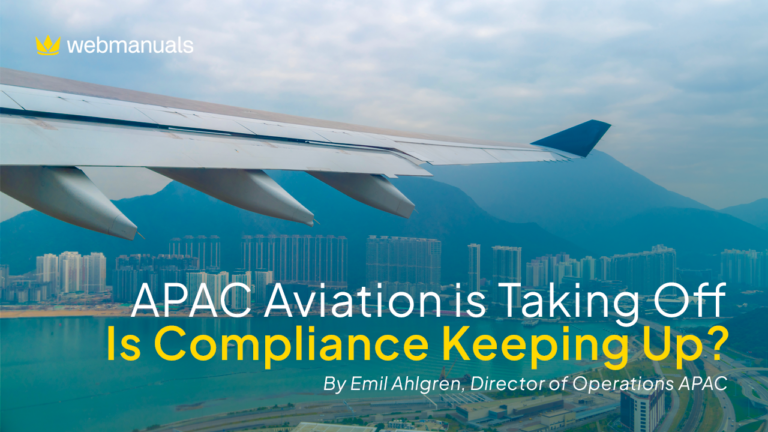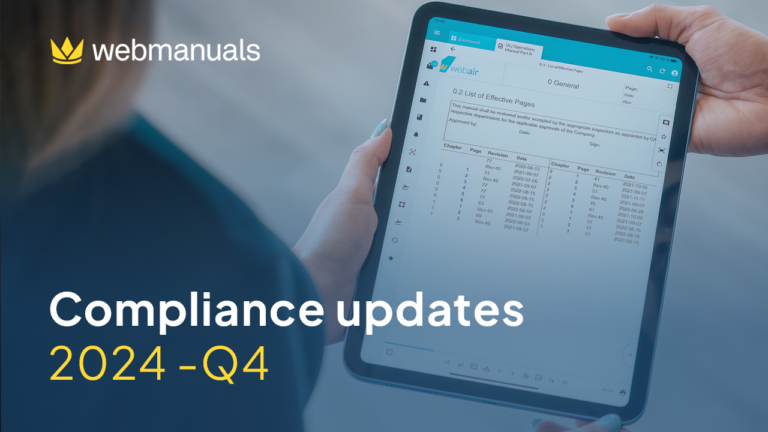Traditional aviation is already a sentence worth discussing. The increasing implementation of innovative and modern technology in the aviation industry is evolving operations at a fast pace. Advanced control, management, communication, and maintenance tools are breaking into the operations, fostering more effective and safe airspace.
According to industry experts, the trend will increase in the upcoming years, and the aviation digital revolution will take over the horizon. At Web Manuals, we have explored the future scenario and analyzed the future challenges in the digital landscape. Here you’ll find the top five topics to tackle the expected roadmap for 2023:
Advanced digital documentation
It’s becoming clear that digitization is imperative for every organization. A significant outcome the industry got from the Covid crisis, was the importance of moving forward toward digital documentation. For most companies, analog work and non-digital documentation stopped abruptly, which forced the transition to adopt tools to support electronic document management.
This implementation during the past years has driven the evolution of digital systems into an essential part of operations, providing relevant data that enhances endeavors at all scales. Organizations can better understand the day-to-day labor and refine processes at this new stage through data compilation and analysis.
At the Digital Aircraft Operations IATA webinar, experts discussed digital initiatives for developing safe and cost-efficient operations. Namely, connectivity emerged as a key topic in improving crew safety. Connected aircraft, for instance through aligned EFBs, enable proactive decision-making, monitored practices, and predictive maintenance.
For example, Aeronautical Information Management has shown great value in increasing pilots’ performance when using in-flight data. By measuring, analyzing, and creating documents, like digital datasets that provide contextual information, pilots are empowered to make better decisions.
Innovative digital training
The increasing implementation of digital tools requires the constant evolution of crew training. The industry transformation needs to be supported by qualified personnel that knows how to deploy and maintain advanced technological equipment.
Furthermore, digital innovations are also optimizing methodologies to train aviation professionals. Many organizations are implementing digital simulators to emulate challenging scenarios and prepare crew for unexpected adversities.
Aviation experts reviewed this topic at the 2022 EASA Annual Safety Conference. According to them, using virtual reality in training provides safe practice, efficient test capabilities, and measure control. Similarly, augmented reality allows interaction, collaboration, and learning from experts without geographical or time limitations. Therefore, ATOs and air operators are building qualified teams more efficiently and mitigating personnel shortages.
Forward-looking regulations
More and more organizations are seeing the benefits of introducing technology and innovation as an investment in better operations for the future. These technologies are impacting aircraft development, aerospace management and control, maintenance standards, and regulatory frameworks globally. Therefore, regulatory entities need to respond to the changes at the same pace to ensure safety.
With this in mind, the industry is demanding a proactive approach from authorities to facilitate innovation and technological implementations. As mentioned in the 2022 EASA Annual Safety Conference, the upcoming regulations are allowing effective digital implementations for Ground Handling.
When talking about innovative challenges, the panelists suggested future coordination between policy-makers to allow single worldwide certifications for innovative aircraft. For example, a unified and simplified process could easily support certification for electric aircraft and electric engines as well as their future demonstrations.
Electric and unmanned systems
Electric vehicles are aiming to become a modern solution to face environmental challenges. Significant projects are currently underway to implement zero-emission vehicles for cargo and passenger flights.
Similarly, unmanned aircraft systems have emerged as an alternative to move towards sustainable transport and reduce environmental impact. The increase in drone usage is moving authorities to create comprehensive and interrelated regulations for the diverse categories of operations. The regulatory framework for UAS and eVTOL is in constant transformation (for example, notice the latest NPA 2022-06) and is urging a proactive approach from the industry to ensure and support their safety operations.
Furthermore, experts are referring to a fundamental change in the aviation ecosystem. For example, they discussed the importance of upgrading air traffic management to keep up with the changes because the airspace structure could improve in supporting new technologies.
Automation and Artificial Intelligence as an ally
As mentioned at Go Digital 2022, we need to explore Artificial Intelligence possibilities and prepare the regulation of new technologies embracing certified AI, Machine Learning, and increased automation. The future of airspace operations must embrace new technology and see the benefits of its development within the industry. In particular, we are referring to IoT, digitization, electrification, autonomy, and ML/AI.
Experts see the rise in automated and digitized solutions as a way to support repetitive and low-qualification tasks to increase safety operations, make processes more efficient, gain cost benefits, and tackle staff shortages. In particular, the evolution of highly automated technologies (ML/AI-based) is increasing the complexity, which requires scalable and dynamic adaptation of Air Traffic Management (ATM).




